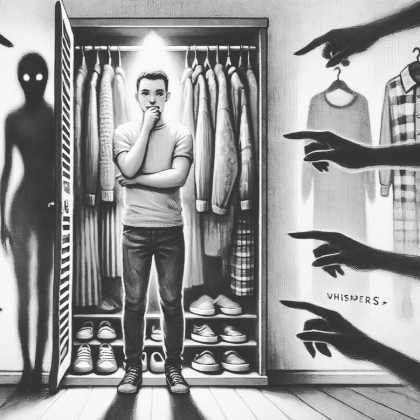The Psychology of Fear in Self-Expression Through Clothing
- atelierpsychothera
- Jan 20
- 3 min read

Clothing is more than just a means of covering the body; it serves as a powerful form of self-expression, reflecting individuality, culture, and emotions. However, fear of self-expression through clothing is a common phenomenon influenced by psychological, social, and cultural factors. This article explores the underlying psychology behind this fear, supported by research and scientific insights.
Understanding the Fear of Self-Expression
1. Fear of Judgment and Rejection
One of the primary reasons individuals fear expressing themselves through clothing is the anticipation of judgment or rejection. Social psychology highlights the human need for acceptance and belonging (Baumeister & Leary, 1995). Dressing outside societal norms or peer expectations can provoke anxiety about being ostracised or ridiculed.
Research Insight: A study by Frith and Gleeson (2004) found that individuals who deviated from societal dress norms often faced scrutiny, leading to diminished self-esteem and reluctance to wear expressive clothing.
2. Cultural and Societal Norms
Cultural expectations and societal norms significantly influence clothing choices. In collectivist societies, conformity in dress is often emphasised to maintain group harmony (Triandis, 1995). Even in individualistic cultures, unwritten rules about appropriate attire in specific contexts can deter self-expression.
Example: Workplace dress codes often discourage bold or unconventional styles, limiting individuals from expressing their true selves.
3. Internalised Insecurities
Personal insecurities, such as body image concerns or self-doubt, can contribute to fear of self-expression. Clothing choices often reflect how individuals perceive their bodies, and fear of negative evaluation may lead to conservative or "safe" choices.
Research Insight: Tiggemann and Lacey (2009) found that body image dissatisfaction correlates with clothing avoidance behaviours, particularly when it comes to revealing or attention-grabbing styles.
4. Fear of Standing Out
For many, blending in provides a sense of security. The idea of standing out through clothing can evoke feelings of vulnerability or exposure. This fear is linked to the "spotlight effect," where individuals overestimate how much others notice their appearance (Gilovich et al., 2000).
Psychological Mechanisms at Play
1. Cognitive Distortions
Cognitive distortions, such as catastrophising or overgeneralisation, can amplify the fear of self-expression. For instance, someone might think, "If I wear this bold outfit, everyone will laugh at me," despite no evidence to support this assumption.
2. Social Comparison
Festinger’s (1954) social comparison theory suggests that individuals evaluate themselves relative to others. Seeing others dressed in ways that align with societal standards may discourage those who prefer unconventional styles.
3. Identity Conflict
Clothing often symbolises identity. Fear of self-expression may arise when individuals struggle to reconcile their authentic selves with societal or familial expectations.
Example: A person identifying as non-binary may fear expressing their gender identity through clothing in environments where traditional gender norms prevail.
Scientific Studies on Clothing and Fear
1. Emotional and Psychological Impact of Clothing
A study by Adam and Galinsky (2012) introduced the concept of "unclothed cognition," which demonstrates how clothing influences psychological processes. The study found that wearing certain clothing can impact confidence and self-perception. However, fear of self-expression may prevent individuals from experiencing these positive effects.
2. Clothing and Social Feedback
Research by Howlett et al. (2013) revealed that individuals’ clothing significantly affects first impressions, influencing perceptions of competence, confidence, and likability. Fear of negative feedback based on clothing choices may lead to conservative dressing.
3. Anxiety and Clothing Choices
Rudd and Lennon (2000) studied the relationship between clothing and anxiety, finding that individuals with higher levels of social anxiety tend to choose neutral and inconspicuous clothing to avoid attention.
Overcoming the Fear of Self-Expression
1. Cognitive Behavioural Strategies
CBT can help individuals challenge irrational fears about self-expression through clothing. Techniques include:
Identifying and reframing negative thoughts (e.g., "People will judge me" becomes "Most people are too focused on themselves to notice my clothing").
Gradual exposure to wearing expressive clothing in low-stakes environments.
2. Building Self-Compassion
Developing self-compassion can reduce fear of judgment. Kristin Neff’s (2003) research highlights how self-compassion fosters resilience and reduces self-criticism, allowing individuals to embrace their unique style.
3. Seeking Supportive Environments
Surrounding oneself with accepting and encouraging individuals can make it easier to experiment with self-expression. Joining communities that celebrate individuality, such as fashion groups or creative meetups, can foster confidence.
4. Small Steps to Self-Expression
Starting with subtle changes, such as adding a bold accessory or experimenting with colors, can build confidence over time.
Conclusion
Fear of self-expression through clothing is deeply rooted in psychological, social, and cultural factors. By understanding the underlying mechanisms and utilising strategies like CBT and self-compassion, individuals can overcome these fears and embrace their authentic selves. Clothing is not just a functional necessity but a canvas for creativity and individuality, offering a powerful opportunity for self-expression when fear is addressed.


Comentarios